~2 yr.old house with drainage tiles laid by the footers and under the basement slab. I’ve been hearing the sump pump cycle every minute or so for several weeks now, so I know the water is high. Go downstairs today to find water on the floor…coming up between the sump wall and the slab…yet my drainage tiles are not flowing faster.
It would seem to me that if water was high enough to come up the slab through the sump/slab joint, it should overwhelm my tiles. Plugged tile is my first guess, but it doesn’t seem right. Anyone with a clue?
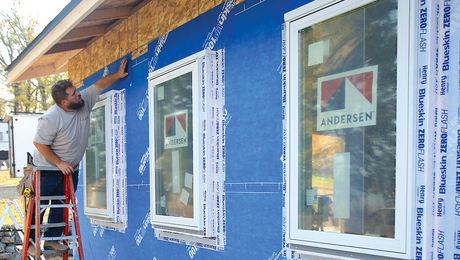

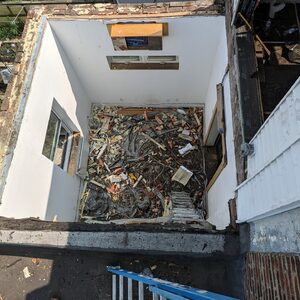
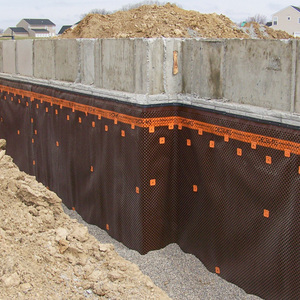
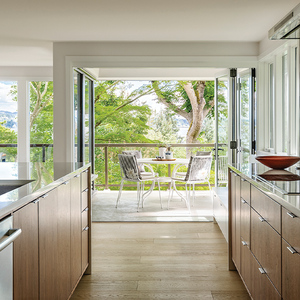
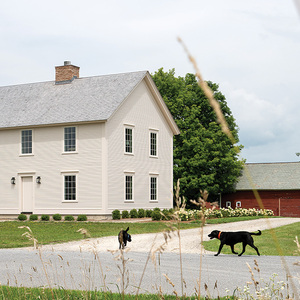













Replies
Doyou have any info on how they were installed?
I was there when they put down the tiles that were encased in a mesh type fabric. The substrate is all sand. When I asked why it wasn't done per the architects spec with pea gravel, they said the mesh negated the need for the gravel. I complained about this to the general, and they went back and piled gravel on top of the tiles. Really not to spec either, but this was just the start of the goatscrew.
I agree with JeffinPA, good chance you have a silty sand. If they didn't follow specs to put in pea gravel, they probably didn't use a good washed sand. The fabric can plug itself from the silt in their sand. Plugged fabric will have the same effect as plugged pipe (although you won't see as much sand/silt in the bottom of the sump).
If you think of the silted fabric as a funnel, like putting oil in the car. It can only allow a small flow through the neck before the level raises in the filter body, regardless of how much flow the crankcase (or pipe) can accept.
Once it raises into the pea gravel they threw on top it can move more freely and try to seep down into another section of silted fabric pipe - or find a hole in your floor.
I don't understand why the drain field is in sand. Why is it not just in gravel? Is this an eastern detail?John
Post 7 he says it was supposed to be pea gravel.
Yea - I've seen the filter sox clog too. I don't normally use it. I prefer septic paper. Anything can fail though under severe enough conditions though...
My X-ray vision isn't working so well tonight. There are a dozen ways to screw up a drainage system.
Welcome to the
Taunton University of Knowledge FHB Campus at Breaktime.
where ...
Excellence is its own reward!
Is it actually water coming up? (or out)
The slab is poured right over footer likely and likely no stone inbetween. In a damp basement environmnent that is the coldest spot and high moisture in the basement will condensate there causing it to look wet.
Best bet is to take some pictures and post them.
Also make sure water isnt coming thru the wall and hitting the floor thru a tie or crack.
Sue your builder for making you a swimming pool and calling it a basement.
Solar & Super-Insulated Healthy Homes
Are you sure the exit pipe is clear? Or does the sump come on, pump the water up into the pipe, and then as soon as the pump cuts off the water just runs back down... Maybe the exterior end of it is crushed...
Edited 2/19/2008 9:31 pm ET by Matt
Exit pipe is clear, I can see where it is draining. I terminated the pipe about 30 ft from the house, downslope. It's apparent that the water is being removed. The puzzle is why is the ground water not getting into the tiles and instead coming up the slab.
Maybe the ground water is lower than your pipe and coming up through hydrostatic pressure for some reason. Had that happen once unfortunately on a hillside with a ton of water problems. Simple house drain was not enough.John
You have drain tile that needs to go to daylight and you have a sump discharge pipe. Are they connected at some point or do you have two separate outlets ?Was the foundation drain pipe laid on top of the footing or next to and below the top of the footing? What is the relative elevation between the slab and the drain tile? Is the back flow prevention valve working on the sump pump as another poster suggested?
They can't get your Goat if you don't tell them where it is hidden.
My drain tiles go to the sump. The pump discharge goes to daylight. The tiles were laid next to the footing, at the same level, well...not on top. The slab is on top of the drain tile. To be clear, there are two sets of tiles that drain into the sump. One goes around the periphery of the house, the other is from a grid that runs under the slab. Both come to the sump under the slab. There are back flow valves on all the pumps (main, redundant, battery back-up). The is very little slope on the property, only what resulted from back filling.I can see water flowing up the slab at the edge of the sump. To fix the problem, I cut some slots on the sump "container" so the water will flow into the sump.
From your description , and IF your fix works then it sounds as if the pipes are either silted up or blocked at the sump. Does the sump have openings the drain pipes empty through? I mean can you actually see the discharge ends of the drain lines at the sump?
They can't get your Goat if you don't tell them where it is hidden.
To be clear, there are two sets of tiles that drain into the sump. One goes around the periphery of the house
Bad idea - lets the perimeter groundwater into the house
the other is from a grid that runs under the slab.
That's fine and how it is supposed to be.
Both come to the sump under the slab.
This is the problem - the drainage piping outside the foundation needs to be kept separate and led to daylight, or, if not possible, an exterior sump + pump. Exterior water should never be allowed to come to the interior.
Jeff
I agree. It sounds like bad design AND bad install. Those interior drains in clean sand should be carrying water to the sump instead of letting it up into the living space, so I'm thinking they are silted too
Welcome to the Taunton University of Knowledge FHB Campus at Breaktime. where ... Excellence is its own reward!
Thanks. But any idea why the water isn't getting into the tiles and coming up the slab/sump seam instead?
Water follows the path of least resistance.
Jeff
Draining perimeter weeping tiles under the footings into a sump is/was standard building practice up here in Canada (Ontario). Even when there were storm drains under the road they still drained them into a sump inside the house though not sure what they are doing now.
Many houses had sump holes that never even had a pump because there was never a problem but code made the builders put in the sump hole.
roger
Water always wins.....just look at the Grand Canyon.
Based on one of your earlier posts, it sounds like your sump basin/bucket is not perforated with holes all the way around and on the bottom. This may be your problem; the basin is actually keeping water out, except where the pipes enter it. I know that the ones sold at the big boxes aren't perforated; I bought one from Basement Systems which is perforated with 3/8" holes . In a recent Ask TOH, Tom Silva installed a sump pump in a basement with a water problem and cut the bottom out of the plastic basin so that the water would flow into it. With this type of setup, the pump actually sucks water into the basin when it goes on (assuming there is clean gravel beneath the slab) and keeps the water level below the slab.
Thanks Tom. I've been thinking about putting more holes into the basin. Your post validates this idea.
I drilled a series of holes around the outside of my sump pit to get it to allow more water in. Just don't drop the drill in.
I agree that opening up the sump to provide easier inflow is a good place to start .
They can't get your Goat if you don't tell them where it is hidden.
Just a wild thought - Plumbers have those cameras they they can send down drain lines to look for blockages. If you're thinking that part of your tile might be damaged, maybe you could hire a plumber to send a camera through the tile to see if you could see anything.
Why doesn't Super Glue stick to the bottle?
Excellent idea, Boss. I'll file this, I know it may come to this later. Thanks.
From the guy's post, it wasn't entirely evident to me that the exterior drains are tied to the interior sump. He said "periphery drains" (or similar). I'm not really sure what that means. Outside of the outside perimeter or inside of the outside perimeter???....
I guess he needed a sump pump outside too.
Also, it almost sounded like he has 3 sump pumps? A grid of drain tiles under the slab? If so sounds like the builder saw this coming... Maybe the guy should built an ark on this particular lot rather than a house.. :-) I'd be curious who's idea it was to build a basement here.... or, maybe they dug the hole and "found" a spring...
Lots o pinions bout how to install draintile.
With a flat lot, if you have exterior draintile or interior draintile, IMO, you need to bring it to the sump crock and eject to outside. (exterior draintile is around the outside of the house at the footings and inside is right under the slab)
From what you describe you have interior draintile and a diagonal piece of draintile perhaps to help with passive radon. (or the builder knew that static pressure could push the water up faster than the water could level out in the sand)
Water seeps thru sand, stone dirt, etc. It seeps thru stone faster than sand and dirt, and runs thru a draintile pipe. Because you have a sock around your draintile pipe, my guess is that you have silty sand and the sock is clogged. With the sock around, it is very unlikely that enough sand would get thru to clog the draintile pipe.
If this is the case, then you could drill a hole in your slab and have water running up thru the hole. (not pretty)
The only solution that I know is to breakout the slab, dig out the draintile and sand, add stone, new draintile and repour.
Prior to doing that, I agree that you should attempt to drill some holes around your crock and definietly get something in writing over to your builder.
You are not talking warranty item, you are talking latent defect or willful neglegence since you brought it to their attention and they disregarded you. (Willful neglegence is tougher to prove but might raise a few more hairs on the builders neck)
I would start reasonably and ask them to fix it properly and give you something in writing accordingly. If no response from them, then get an attorney.
From your definition, I have exterior and interior drain tiles. Do I have a case of clogged sock then? I've thought about this possibility. What is the chance that my setup (tiles partially set in the sand with gravel on top) could be clogged to prevent water from getting in the tiles, after 2 years? Guess this could only be the possible cause. My thinking is if silt can get to the sock and clog it, couldn't it easily pass through the gravel (if it were there) and get to the sock as well? Wouldn't all tiles eventually fail regardless of construction?Had such a terrible time trying to get the builder to fix the steam shower problem, fixing something like this is going to be a total nightmare...Thanks.
If you have exterior and interior draintiles, something is really awry. I have never seen a combo system fail.
Are you in a community? Are there other homes around you? What experiences are they having?
Most codes require 4" of stone under basement slab and if that were done, the likelyhood of silt migrating up and thru and clogging up the draintile is minimal. Some would likely pass thru and run thru the sump pump depending upon the size of silt and its ability to stay suspended in water.
Typically exterior draintile is protected with filter fabric from the top, but not interior as you dont get much silt going up. Most washes down thru the stone into the draintile ergo put fabric on top and outer side on exterior.
I cant think of any other reason for the system to fail so blatantly. Are you sure the water isnt coming in thru the wall and laying on the floor?
I'd contact builder, give em 3-5 days to respond and then go rent an electric jackhammer and open up the floor in a couple of areas to see what the static water level is in those areas and what the condition of the materials around the draintile pipe is. HAVE YOUR DIGITAL CAMERA AROUND YOUR NECK SO YOU REMEMBER TO TAKE PICTURES EVERY STEP OF THE WAY!!
IF you get some good picts, post em.
'Drain tiles' - please describe
Jeff
Plastic 4" flexible tubes that are perforated and encased in a mesh "sock". I have them on the outside, by the footers, and a network under the basement slab, that both drain to my sump.
Corrugated black plastic piping is really marginal as exterior drainage piping due to tendency to crush. I always use perf PVC. Your exterior piping is likely silted up (also a problem with corrug. black plastic) or crushed.
Jeff
Does perf PVC have less tendency to get silted up? What you suggest could be the cause, but any idea why the interior network is not working (as it should) either? Both drains are flowing, but not fast enough to remove the under the slab water.
Usually the failures I have seen are from the holes in the pipe being silted closed, while there is still some room in the pipe itself. I think the perforated PVC has an advantage there because of larger holes, and also because water can flow faster in a smooth wall pipe than inside the corrugated tile. I believe that the faster flowing water will carry more silt than corrugated pipe.Add in the benefit of sturdy walls less likely to collapse, and being easier to lay hard wall with a slope (avoiding dips that corrugated is more likely to get if not carefully watched) its a no-brainer to spend the extra cash.
Man I wish I knew these things before...
I dont know what your experience with flexible black ADS pipe is Jeff, but I have never had a problem with it silting up or crushing unless it was driven over or mashed by a machine.
I built all over South Jersey for years and now in PA.
I would not even think of spending the extra time to put in PVC
I would not use a sock though.
Pipe wrapped with stone 4 sides and covered with fabric for exterior draintile.
"I dont know what your experience with flexible black ADS pipe is "
Bad ... never again.
Jeff
Apparently.
I have not had that experience yet so plowing ahead come what may.
Did someone do something wrong and the pipe was unforgiving or was it a limitation of the material that did you in?
Standard soil engineer spec in my area is SDR 35. Agree the black flex is an inferior product. Hasn't looked too good on some remodels where we dug it up.John
I have seen bad of both sdr and ads
If not wrapped well with stone and covered well with filter fabric, I believe both could be a problem.
If installed properly, I believe either can work great.
I would love to know stuff that doesnt work and why so I can learn from others experiences.
Question: Did you have this house built or was it already at least partially done when you got involved?
Had this house built. I do have 3 pumps in the sump. When we tested the lot, soil engineer said water table is at 8~8.5 ft. and a basement is possible. I had it put in 5 ft. deep and back filled. The drainage system has been working well except this last time. The pump runs seasonally, maybe several months (cycling continuously) a year. We are at 2.4 ft. above flood stage. The last time this happened, the water went back down after a few days and we had no problems, but this time it's holding steady.
Here's what I think:
You started with a marginal site - you (or the builder) knew that going in, that is why you got a soil engineer to start with. If the soil engineer did write a letter if you look at objectively, you will see it has several disclaimers in it - so he is not responsible. The lot is not sloped enough to day-light your drain tiles - strike 2. So, the builder made an honest effort to provide an adequate drainage system - a grid work of drain tile inside, pipe with filter sock outside, and THREE sump pumps. Some guys are saying a 4th pump was needed outside. OK. Actually you probably should have the double redundancy out there too making it SIX sump pumps... if you want to look at it that way. Now the water table has risen - for whatever reason - excessive rain or what have you. Strike 3. You are really just kind of $crwe.... You hired a builder not a magician. What these guys are saying about black flexible drain tile being inferior is true to some degree but it's probably used in 95 % of the foundation drainage systems installed in the last 15 years. (people who don't build for a living don't know that...) Like I said before - you might be better off with a boat then a basement. I think that generally the water infiltration is just overrunning the sump pump and the system in general. If your black pipe system is failing after only 2 years, my bet is even if the builder (or the subcontractor) had used PVC pipe, it only would have lasted another year or 2 at the most...
It's real easy (in hindsight) to say what should have been done. Doesn't help now. I don't think your builder was remiss. This sheet just happens. Sorry it was you. You are getting a lot more of that ahole view than solutions...
Hey - here is a thought - did a foundation or foundation waterproofing contractor install the drainage system? If so, contact them.
One final word... take what you read here with a grain of salt. Some great resources available, but there are also some posers too. Guys who haven't been paid to get their hands dirty in the last 20 years - if ever... Some of these guys talk a good game by simply repeating what they have read here (or elsewhere) or just based on what they can Google up... But then you have been around long enough to know that...
Matt:True 'nuff. Perhaps the site was marginal for a basement. Don't think my neighbors have them, but I relied on the engineer and added a few feet of margin. Just figured I got a decent setup in the sump, with a redundant pump in place so I can change out the primary when it fails, and battery backup when power goes out. Didn't count on my drainage tile to be the weak link. Thanks.
You said you added holes to the sump crocks to fix the problem. Is it still going on? If so, sounds like it's time to dig it up - at least a test area or 2 just to try to replace speculation with facts. Like maybe a place outside where the finish grade is closest to the drain pipe? You probably could have dug a hole in the time it took me to type this and the previous post :-)
Or, (and?) bust some concrete up in the basement. I know that sounds harsh but in new construction we have to do it occasionally when an underslab pipe gets put in the wrong spot and it's not a big deal. Sometimes they use an electric jackhammer, but sometimes just a sledge hammer. Those concrete guys carry 20#ers :-) . Is there wire and/or rebar in that slab? Hopefully not. Even a rotary hammer works pretty good - not a hammer drill though...
OTOH it seems unlikely that the under slab drain system is filled with silt unless it came in from the outside via the pipes. I assume this under slab pipe doesn't have the sox on them? Is there silt/sand/whatever building up in the sump pits? (maybe you said that before?) I guess there are several pipes that dump directly into the sump pits. Can you reach your arm (hand) into any of these to see if there is a bunch of stuff inside the pipes. The above suggestion about the camera sounded pretty good. I've had my plumber come out with one of those. I think he told me that the entire setup only cost about $4 hundred... not suggesting you buy one but maybe you could rent one somewhere. I think it was just a regular digital camera with the fiber optic adapter and "snake" IIRC. There was a light on the business end. Still, it's not exactly like looking at a nice clear digital photograph...
What kind of soil (sub soil) do you have at your building site? More granular soil is less likely to clog the sox but maybe more likely to migrate into unprotected pipe drain holes. There wasn't any sand used in the backfill process our under the slab was there? We use washed crushed blue stone for drainage systems. It's called #56 pr #67 and is around .75 to 1" in size. Stone products are highly regional though so you need someone fairly local to give more info about that. For example, here pea gravel is expensive and only used for decorative purposes.
BTW - in case you didn't figure it out I take offence when people just jump right on the band wagon of "your builder is a hack and needs to be sued" before collecting all the facts. Kind of like lawyer jokes :-) Remember several years back when it was made known that lawyers have feelings too :-) It's gotten to the point where at work we have to have people sign a bunch of disclaimers when we sell them a house...
I'll throw in a possibility that I don't think has been mentioned. If the pipe used for the collection system is flexible corrugated pipe and no gravel was used, there may be a low place in the pipe caused by back-filling. In my experience that is a more common problem with corrugated pipe than is crushing.
Keeping a constant slope on flexible pipe is difficult, and if not properly bedded when installed, the backfill is likely to cause problems. My experience is mostly with septic systems and a bit of landscape drainage, but the principles are the same. We don't allow corrugated pipe to be used on disturbed soil.
A low spot will not stop the water flow completely, as long there is sufficient head pressure pushing the water through the pipe, but it will impede the flow and will be more prone to clogging.
I have seen the same and that is the reason I quit using flex pipe.
They can't get your Goat if you don't tell them where it is hidden.
Jim:This sound totally probable. I can see this with the external drains. But the interior ones seemed better off. When I saw them put in the slab, it looked impressive enough, with laser levels and care to put things down. The sub soil was undisturbed, and the grid looked OK. But yeah, this would explain a lot of things.
I don't think I'll be digging down to the tiles any time soon. I am sure there is water there.IIRC, the slab sits on top of poly sheeting, stone and drain tiles (not sure of the order). I think the poly is keeping the water from coming up elsewhere. The notches that I cut in the crock is working to keep the water in the sump, and the flow is decreasing now.The sub soil around here is all sand (sugar sand?). Engineer said this area was the bottom of a prehistoric lake. Here is the other problem if I were to cut more holes in the crock, erosion from water draining into the sump. I don't see silt, but there is a bit of sand outside where the pump discharges, and some sand in the sump. In fact, when I discovered the water, there was a couple cups of sand at the edge of the pit. It only dawned upon me later when I found water coming up between the slab and the crock that the water carried the sand with it. If I were to increase the flow into the crock by putting in more/bigger holes, I'd be moving a lot of sand when this happens again. Guess the trick is to remove the water without the sand.
Somewhere in one of your posts you mentioned a nearby river or something of a mention of being 2ft below flood stage.
I have a spring running right up through the ground in my back yard every year just about the same time the maples start running sap. By the time the leaves bud, it's pretty much over.
If something near you is near flood stage then your water table has likely risen significantly. We've had some really soaking rains here a week or so ago and the hills are still running all over the place. Water tables have all risen.
Perhaps just waiting it out??
And I'm curious about how the height of the water table was determined and by how much it could vary given seasonal changes and near flood conditions.
[email protected]
Going back to your post #7, are you saying that the pipes were backfilled with sand and not pea gravel, as specified? And that some pea stone was put on top of the pipes when you complained? If so, that seems like your problem, i.e. water not getting to the pipes fast enough. This sand presumably is packed down pretty good and is not going to let water pass thru nearly as fast as gravel with large(relatively speaking) voids. That's why the engineer spec'd it. So you get a "backup" when there is a lot of ground water which then takes the path of least resistence, the joint between the wall and the floor. Think of 2 large flower pots, one packed with sand and the other packed with gravel and then pour water into both. Which would overflow first?
You meant to post the the OP, not me.[email protected]
Sorry!
Yeah, all I can do now is wait it out and monitor it closely. The basement is not finished, but plan was to completely finish it. I was going to wait until we can install a standby generator to complete my water pumping system, but now this :(As for determining the water table, relied completely on the engineer. He took a few cores and noted where the discoloration was. His reading was the limit, and I didn't ask about the variations.You said you have a seasonally active sump? If so can you tell me how long I can expect a REALLY active submersible sump pump to last? I believe the cycling is what's tough on it, and mine has been going off every minute, 24/7, for a couple of months now. And it does this a couple of times a year.